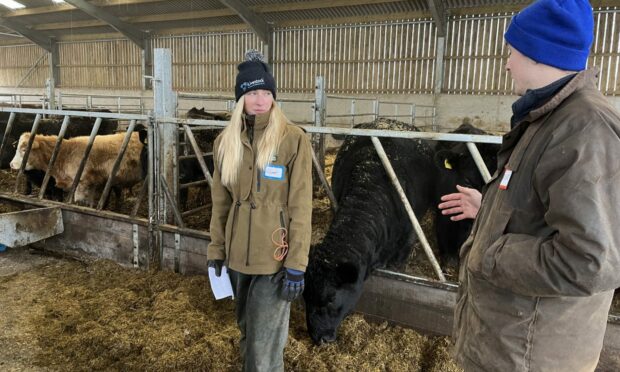With three generations involved in the farming business, it was a real family affair for the Duncans who recently held the first meeting on their Stirlingshire monitor farm.
More than 70 attendees gathered at the family’s Lands of Drumhead unit near Balfron to hear about their drive for a sustainable future.
Three of Bruce and Shona Duncan’s children – Sally, Rebecca, and Gregor – are becoming increasingly involved in running the farms and the family’s diversified agri-tourism enterprises.
The farm runs over 540 hectares and is home 165 suckler cows and 1,100 ewes with most progeny sold store.
Two bespoke luxury glamping pods named The Heft and The Hirsel are also on the farm and the family sells their home-grown, grass-fed lamb, hogget and mutton.
More than 70 attend first meeting
The focus for the first meeting was on housed cows and calves on the farm.
Beef Shorthorn, Aberdeen-Angus and Simmental cross cows are put to an Aberdeen-Angus or Simmental bull with the aim of producing replacements, and to another Aberdeen-Angus or a Limousin for store production.
This year, cows scanned in-calf at 95%.
Attendees were impressed with the family teamwork, farm infrastructure, herd conception rate and its ease of calving.
They also noted that Bruce collected good farm information in his ‘wee notebook’ but that this data was not utilised fully.
It was suggested that this could be analysed to further improve cow selection by identifying poor performing cows.
As the farm takes two cuts of silage, it was suggested that the family could analyse both.
Weighing calves and heifers and feeding the different silages to appropriate groups would help better target nutrition.
Those who attended also thought the family could look at their calving facilities and make better use of their shed space.
The sheep flock breeds its own replacements and the lambs reared last year were 148% of ewes put to the tup.
They use a Texel cross Bluefaced Leicester over the Blackface ewes, Texel tups on the Mules, and Texel cross Beltex tups over Texel cross ewes to produce lambs for finishing.
Cows scanned in-calf at 95%
Given the good lowland ground, attendees thought there was potential to look at finishing more of the lamb crop by using stubble or forage crops. Foot health was also mentioned as a priority.
Another suggestion from attendees was that the family should set clear business aims and goals. Bruce says he is conscious that both livestock systems are currently relatively simple, with low inputs and low outputs.
“In all honesty, we don’t know where the business is headed,” said Bruce.
“The younger generation are enthusiastic and are looking to make changes. We are very open to new ideas and happy to share any new ones with the wider farming community.
“As a family we are looking forward to having fresh eyes on the business and new outlooks on how we can improve productivity.”
Shona added: “We greatly appreciated the support and input from everyone who came along and it was reassuring to get discussion on what we are doing right and the areas where we need to focus.”

